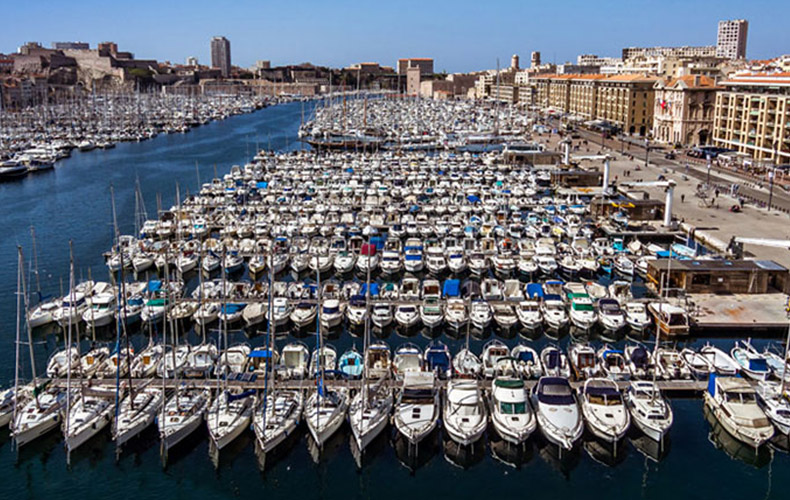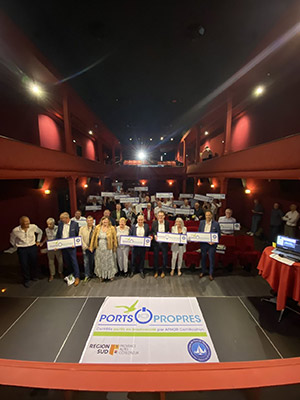Vacations at the right port with “Clean Ports

Le 6 juin 2023, 24 ports de plaisance de Provence-Alpes-Côte-D’azur ont reçu la certification « Ports Propres » et « Ports engagés dans la biodiversité ». Ce signe de reconnaissance de bonnes pratiques écologiques leur a été remis lors d’une manifestation organisée par l’Union des ports de plaisance de Provence-Alpes-Côte d’Azur et Monaco et le conseil régional de Provence-Alpes-Côte d’Azur.
” The approach has borne fruit: we’ve seen a return of flora and fauna to the ports involved ,” says Véronique Tourrel-Clément, general delegate of the organization, which groups together 135 ports and 60,000 berths, in 2019.
More recently, the ports of Mèze (Hérault) and Saint-Cast-le-Guildo (Côtes-d’Armor) have also been awarded the title. Today, AFNOR Certification, which assigns an auditor to the requesting port, has 73 of its own ports certified as such, and 35 with a special mention for biodiversity. This distinction will carry even more weight once the International Organization for Standardization (ISO) has made it a voluntary standard, and thus crosses borders. This work will be carried out under French animation.
In Bonifacio, an undeniable return on investment
In Corsica, Bonifacio led the way. Certified “Port Propre” since 2019 and “Port engagé dans la biodiversité” since 2020, the site has implemented a comprehensive approach that is now bearing fruit. It’s not a question of one-off actions, but of constant, long-term reflection in search of coherence and continuous improvement,” stresses Michel Mallaroni, Director of the Bonifacio marina, which has 350 berths and registers 11,000 calls every year. This includes anti-pollution training for staff and the choice of more environmentally-friendly equipment.

Award of AFAQ Clean Port certification to UPACA ports on June 6, 2023.
This approach encourages the port’s teams to integrate these dimensions into all their projects, as a common thread. “This strategy permeates our development and appeals not only to yachtsmen and employees, but also to the residents of Bonifacio, since this is a municipal port, geographically located in the heart of the town. Awareness-raising campaigns, such as the one carried out in the spring of 2023 with ocean racers, help to communicate our commitment. In terms of brand awareness and credibility, the return on investment is indisputable,” continues Michel Mallaroni.
Among the actions carried out under the “biodiversity” pillar, the port has installed artificial nurseries on its pontoons and 14 eco-designed lockers for boats over 24 meters. ” In concrete terms, these structures placed on the seabed form artificial reefs in which marine flora and fauna proliferate,” explains Michel Mallaroni.
Cinq piliers pour une certification
Gestion des déchets, fuite depuis les aires de carénage, eaux usées… Les ports sont soumis à de nombreuses sources de pollution, sans parler des sources externes, comme les orages et les eaux venues du bassin versant… Pour de nombreux professionnels, s’emparer du sujet résonne comme une évidence. D’abord en raison d’une passion commune de la mer, ancrée chez tous les plaisanciers. Mais aussi pour une question d’image et de développement stratégique : des ports pollués et une mer sans biodiversité n’attireraient plus personne, ce qui signifierait la fin de leurs activités.
La certification « Ports propres » répond à cette attente. « La démarche repose sur une méthodologie robuste et des audits sur site. Ainsi, chaque année, l’auditeur AFNOR s’assure du respect des exigences et de l’amélioration des pratiques des ports certifiés », souligne Béatrice Poirier, responsable du pôle Transition écologique chez AFNOR Certification. Cinq étapes jalonnent le parcours des certifiés :
- Étude et diagnostic environnemental. État des lieux de l’existant, hiérarchisation des sources de pollution et programme d’actions pour améliorer la protection de l’environnement.
- Lutte contre les pollutions chroniques, c’est-à-dire les déchets liquides et solides produits par les activités portuaires et les usagers : traitement des eaux de carénages, de traitement des déchets spéciaux, de traitement des déchets ménagers, des eaux usées…
- Lutte contre les pollutions accidentelles (comme des barrages flottants ou absorbants contre une nappe d’hydrocarbures), économie d’eau et économie d’énergie.
- Formation du personnel portuaire à la démarche, tant théorique que pratique.
- Sensibilisation des usagers du port via des assemblées portuaires ou encore une signalétique nationale « Ports propres ».
Certified ports can then complete their commitment with the “Clean Ports Active in Biodiversity” label, with specific areas to work on, such as nesting areas for birds, insect hotels or breeding grounds for marine fauna. “One of the strengths of reference systems? Adapt to the specific characteristics of each port, taking into account its constraints, activities and challenges, concludes Michel Mallaroni. While the approach remains voluntary, we believe it is essential to meet the challenges facing not only marinas, but the sea as a whole.